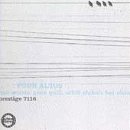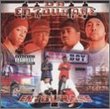| All Artists: Phil Woods, Gene Quill Title: Four Altos Members Wishing: 1 Total Copies: 0 Label: Ojc Release Date: 7/1/1991 Genres: Jazz, Special Interest, Pop Styles: Cool Jazz, Bebop, By Decade, 1950s Number of Discs: 1 SwapaCD Credits: 1 UPC: 025218173421 |
Search - Phil Woods, Gene Quill :: Four Altos
 | Phil Woods, Gene Quill Four Altos Genres: Jazz, Special Interest, Pop
|
Larger Image |
CD DetailsSimilar CDs
|
CD ReviewsNot to be taken for granted. Samuel Chell | Kenosha,, WI United States | 04/16/2007 (5 out of 5 stars) "Sure, it's a blowin' session with a lot of unison heads on standard chord changes but a shame there aren't more of them. (You've heard "The Three Tenors." Imagine "The Four Sopranos"--maybe Callas, Sills, Moffo, and Fleming--singing some of your favorite arias in unison. Some of the passages on this recording reach that sort of full-throated lyricism.) I was reminded of this session when I saw Gene Quill listed among the members on a late '60s Buddy Rich big band recording session. Next I discovered that recordings by Gene Quill have vanished almost as rapidly and irrevocably as he himself did (I can recall once reading in Down Beat magazine a plea for help from some Catholic sisters for donations to pay Quill's medical bills shortly before his premature death--reminiscent of the problems of Mingus' similarly ill-fated reed man, Bobby Jones). Contrary to some indifferent reviews of this session, I certainly have no difficulties picking out the players, each of whom has a very distinctive approach and sound to my ears. Woods is the stand-out with Quill and Shihab a close second and the "mysterious" Hal Stein (what ever happened to him?) holding his own but not quite in the same league). The heads really are quite memorable in their own right, though most musician-listeners should have no trouble recognizing the underlying chord structures. There's not a whole lot of firepower in the rhythm section, with Mal Waldron being a rather minimalist player and Tommy Potter a competent but not particularly strong bassist among the first generation of bebop players, and the indestructible Louis Hayes (hard to think of him as "old" some 50+ years later) on drums. Still, in my opinion this rhythm section swings harder than that of Woods' own team of Gilmore and Goodwin from several decades later. Given Woods' dominant position shortly after the passing of Bird and his reasonably good health over the years it's perhaps regrettable that he was not heard in the company of other major Bird successors like Sonny Stitt, Cannonball Adderley, Art Pepper, Lee Konitz, Oliver Nelson, and Eric Dolphy, especially since all of those guys, along with Phil, were up to a challenge. All we can do is imagine the outcome and be thankful for sessions like this that do document the music during a remarkable period. [Incidentally, the liner notes are small-sized, but it's the complete original set supplied by Ira Gitler. Also, the mastering is superb. For once, Rudy Van Gelder didn't feel it necessary to boost the bass in order to call it a "remastered session" (I've almost had it with "RVG Remasters.") This one even sounds as good as the original LP, with perhaps a bit more "sizzle" in the cymbals. Finally, although this is a Van Gelder-engineered session, the horns aren't "reverb-enhanced" or the piano's sound "bottled up." Definitely, the best all-alto blowing session I've yet come across (none of the irritating distortion of Rudy's unbearable 3-tenor "A Blowin' Session," on which Griffin, Coltrane and Mobley all sound like buzz saws).]" Four Bird Clones J. A. Stewart | NH, USA | 09/17/2003 (4 out of 5 stars) "This is one of several 50's blowing sessions that Phil Woods did for Prestige. Most of his sessions on that label were with a trumpet or regular alto partner, Gene Quill, so a session with three other altoists was a little different. In addition to Woods, the soloists are Gene Quill, Sahib Shihab, and Hal Stein. They are all under the influence of Charlie Parker and end up sounding pretty similar trying to copy his sound (note the cover art which depicts four birds on a wire). I think the casual listener wouldn't be able to tell these guys apart, though Woods and Shihab standout (a little) because of their unique tone. Three of the tunes are lines based on chord progressions to bop hits of the day: "Kokochee" is based on "Cherokee," "No More Nights" is based on "There Will Never Be Another You," and "Kinda Kanonic" on "I'll Remember April." There aren't any solos here that are better than what Bird would have done, but there are some nice moments, especially from Phil Woods. The solos are all fairly short, in comparison to other Prestige blowing sessions where some solos seemed to go on forever. Having four altos who all play in the same style may prove a bit much for many listeners however, so this CD is only recommended to big fans of Phil Woods, Bird copyists, and/or 50's bop blowing sessions." Maybe clones but certainly no clowns Jazzcat | Genoa, Italy Italy | 08/25/2004 (4 out of 5 stars) "It's true, this album is not essential in the proper meaning of the term. It is just one of the hundreds blowing session dates that has been made in that magic 1957. But this one is an extremely good album anyway. It's a bebop album, a blowing session on common Jazz vehicles in the manner Bird would do. To quote Lennie Tristano "Bird could ask royalties for every record made since his", and that's true because he was the most important innovator in the whole history of Jazz music. Jazz was never the same after Bird's coming and legions of players (I might say every Jazz musician his contemporary or follower) learned his lessons and played the way he intended jazz has to be played. Nothing's wrong with it in my opinion. We can't ask to any musician to be a timeless genius and to invent another musical universe like Bird was and did, but this does not make the music of this lesser players less enjoyable. This album proves it. Four alto players here plays some contrafacts (Jazz standards chord progressions with different theme for not paying royalties) in a strictly Parker fashion but did a really good job. They were not even clones (and certainly not "clowns") in a sense because playing in the Parker manner was the only thing to do then and they do it well by the way. Sure these four alto players were parkerians, but I love Parker like I think every jazz enthusiast so listen to parkerian music is always a pleasure for me. And I love to listen to blowing sessions too because they are the true essence of Jazz music so I really enjoyed this album. I agree with the other reviewer that this is not "essential" (this is why I didn't give it five stars) but the music is absolutly good (this is why I give it four). And how could be different. It was the magic 1957 the zenith of Jazz music ..."
|

 Track Listings (6) - Disc #1
Track Listings (6) - Disc #1


